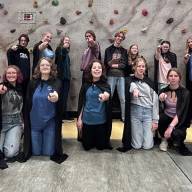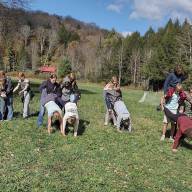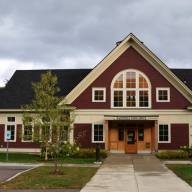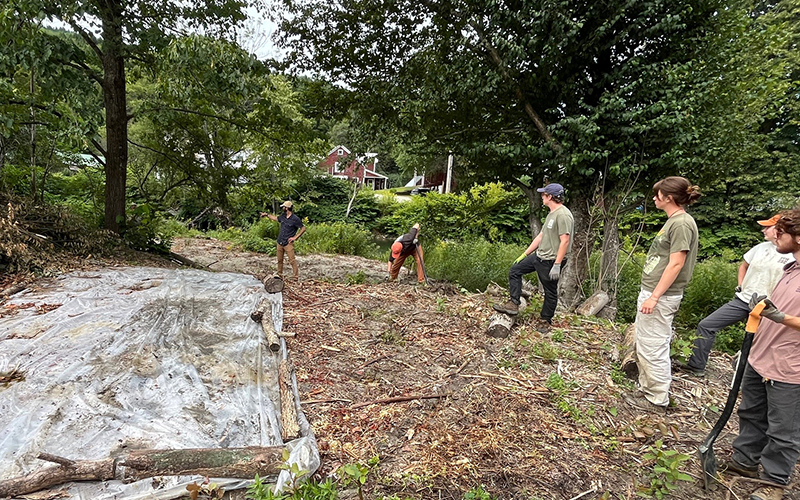
A patch of goutweed covered in clear plastic. Black plastic can also be used. The process, designed to kill or weaken the plant by heat, is called solarization.
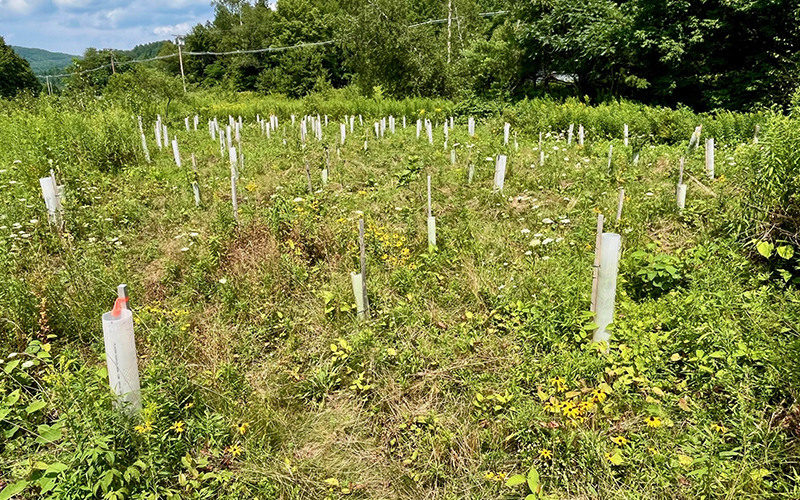
Native trees and shrubs planted at Farley Memorial Park over the past two years in a place that was once a huge knotweed infestation.
When the invasive species initiative in the Mad River Valley got underway a number of years ago, the first focus was on Japanese knotweed. The goals were to stop the spread in selected priority locations, such as the headwaters of the Mad River, high elevation locations where knotweed was spreading, and well-used locations along the Mad River, like Bridge Street and Quayl’s Bend. As local conservation commissioners and volunteers began to make progress on over 293 locations in Warren, Granville, Fayston, and Waitsfield, their attention expanded to restoration of the native habitat that had been overtaken by knotweed. A second focus was embraced – plant native trees and shrubs, especially on riverside sites where knotweed was being managed; think Riverside Park in Warren and the Austin Parcel in Waitsfield. In the past several years over 2,000 native trees and shrubs have been planted.
In doing this work, organizers began to notice that in some of the areas where the knotweed was coming under control, other invasive species, especially honeysuckle and goutweed (also known as bishop’s weed), were lurking and spreading. In clearing the knotweed, they were inadvertently creating conditions for these other invasives to spread. Ecologists call this secondary invasion. As this realization emerged, they turned for advice to advisors Drs. Noelia Barrios-Garcia and Mariano Rodriguez-Cabal, who called experts at the University of Vermont in invasion ecology, Dave Maroney, a recent graduate from the UVM’s field naturalist program, and Brian Colleran, a consulting ecologist with extensive experience in knotweed control.
Dave Moroney suggested adopting a holistic management strategy. He wrote “To protect management efficiency, prevent secondary invasion, and promote site recovery, it is recommended that potential project sites be managed holistically, considering the full suite of invasive species present. For example, efforts to remove mid-size plants such as shrub honeysuckle (Lonicera spp.), winged euonymus (Euonymus alatus), and Japanese knotweed, may be wasted if low-growing rapid colonizers such as goutweed (Aegopodium podagraria), and wild chervil (Anthriscus sylvestris) are present to take their place. Dr. Barrios-Garcia encouraged the local team to think beyond trees and shrubs and consider incorporating native herbaceous species to advance restoration plans and help prevent secondary invasions. Brian Colleran advised using native seed mixes with a wide variety of species.
At the Virginia Farley Memorial Park the teams have begun experimenting with this third focus: holistic management of invasive species and introduction of herbaceous species into restoration plantings. The UVM intern crew and community volunteers are concurrently managing knotweed, honeysuckle and goutweed in the northern section of the park. The knotweed is being cut and dug, honeysuckle branches are being cut low to the ground and covered with black plastic, and goutweed is being solarized (covered in clear plastic). A combination of native seed mixes (warm season grass mix, wildlife mix, moist site mix, dry site mix) were then spread throughout the site. In the past we simply used a VT conservation grass mix on managed sites. In mid-fall, a diverse array of riparian-appropriate native trees and shrubs will be planted. Organizers will assess how these new strategies work out, refine them, and employ this third focus to other sites in Warren, Waitsfield, and Fayston.





